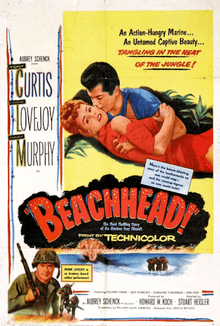Beachhead (film)
| Beachhead | |
|---|---|
 1954 theatrical poster | |
| Directed by | Stuart Heisler |
| Produced by | Howard W. Koch |
| Written by |
Richard Alan Simmons Richard G. Hubler novel I've Got Mine |
| Starring |
Tony Curtis Frank Lovejoy Mary Murphy Skip Homeier |
| Music by |
Arthur Lange Emil Newman |
| Cinematography | Gordon Avil |
| Edited by | John F. Schreyer |
| Distributed by | United Artists |
Release dates | 5 February 1954 |
Running time | 90 min |
| Country | United States |
| Language | English |
| Budget | US$450,000 |
| Box office | US$1,400,000 |
Beachhead is a 1954 Technicolor war film based on Captain Richard G. Hubler USMCR's 1945 novel I've Got Mine. It was filmed in Kauai by Aubrey Schenck Productions, released through United Artists and directed by Stuart Heisler.
Plot
In late October 1943, a battalion of U.S. Marines have landed on Choiseul Island to create a diversion for the impending Allied invasion of Japanese held Bougainville Island.
Four of them (Frank Lovejoy, Tony Curtis, Skip Homeier and Alan Wells) have been selected to do a reconnaissance patrol and find a French planter (Eduard Franz) and his daughter (Mary Murphy) who have sent a message to the Allies. The patrol must confirm that the message is authentic, and that the planter is still alive, who can give the Marines valuable information needed for a successful amphibious landing by the Allied forces.
Cast
- Tony Curtis as Burke
- Frank Lovejoy as Sgt. Fletcher
- Mary Murphy as Nina Bouchard
- Eduard Franz as Bouchard, French Planter
- Skip Homeier as Reynolds
- John Doucette as Maj. Scott
- Alan Wells as Biggerman
- Akira Fukunaga as Terrified Japanese Sailor (as Sunshine Akira Fukunaga)
- Dan Aoki as Japanese Sniper
- Steamboat Mokuahi as Malanesian, Island native
Production
Filmed on Hawaiian locations on Kaua'i including Hanalei Pier,[1] the film was budgeted at US$450,000 with the producers arranging to obtain Tony Curtis from his contract studio of Universal-International.[2] The producers used Hawaiians for many of the roles in the film such as Sam "Steamboat" Mokuahi,[3] Democratic Party organiser Dan Aoki, and Akira Fukunaga the latter two veterans of the 442nd Regimental Combat Team.
The producers went to the Marine Corps to seek technical assistance for the making of the film. Though the Corps liked the idea of the film, they refused to provide cooperation. As two of the four Marines were killed in the screenplay, the Public Information Officer said that the Marines would not provide any assistance to any film displaying the Corps taking 50 per cent casualties as they were in the midst of a new recruiting campaign emphasising a new less danger seeking image.[4] The producers visited the Pentagon and were provided Navy, Coast Guard, and Hawaiian National Guard assistance in making the film.[4] The film was titled Missione Suicido (Suicide Mission) in Italy.
Mary Murphy felt that Stuart Heisler was trying to make her look like a version of the director's own wife. She also was nearly attacked by a drunken cameraman on the film's isolated Hawaiian location.[5]
Notes
- ↑ http://www.hawaiianencyclopedia.com/hanalei-history-part-5.asp
- ↑ p.75 Mirisch, Walter I Thought We Were Making Movies, Not History 2008 University of Wisconsin Press
- ↑ http://archives.starbulletin.com/98/06/22/news/obits.html
- ↑ 4.0 4.1 p.125 Suid, Lawrence M. Guts and Glory: The Making of the American Military Image in Film 2002 University of Kentucky Press
- ↑ The Wild One's Sweetheart: Mary Murphy Interviewed, Paul and Donna Parla.
External links
- Beachhead at the Internet Movie Database
- Beachhead at AllMovie
- Beachhead at the TCM Movie Database
- original film trailer http://www.youtube.com/watch?v=WxxoNqDgVRY
| ||||||